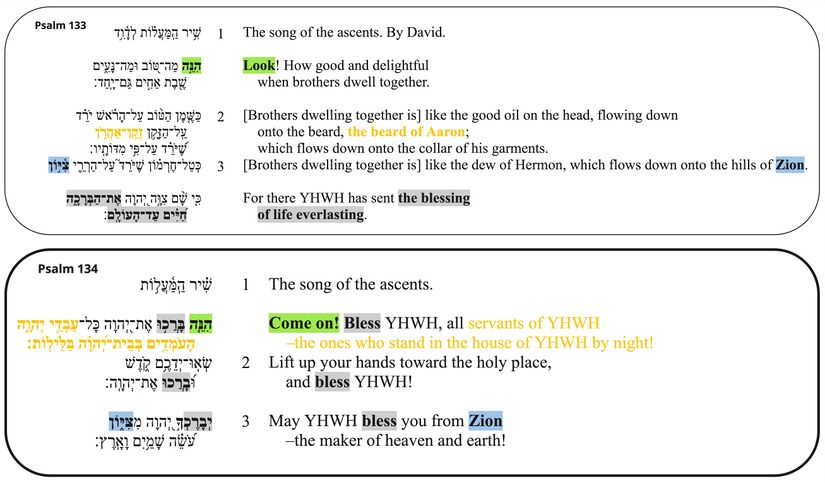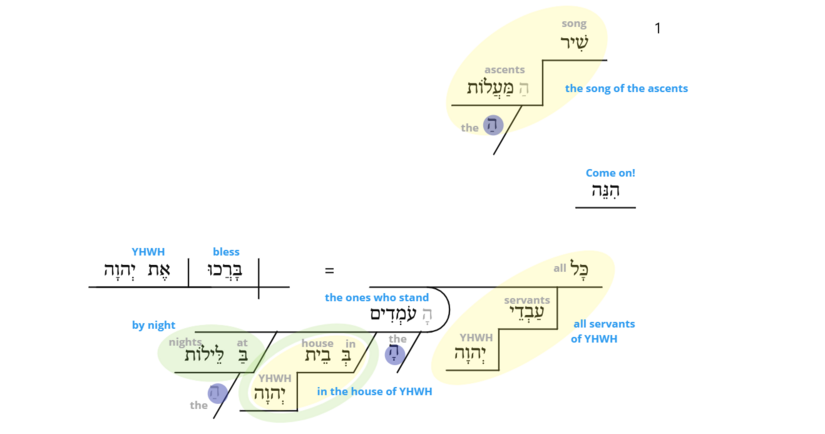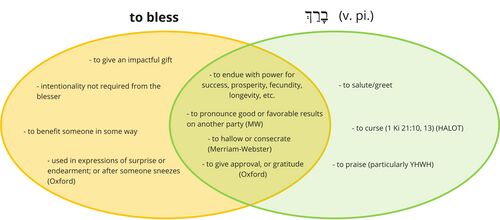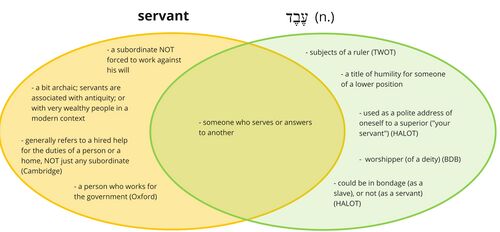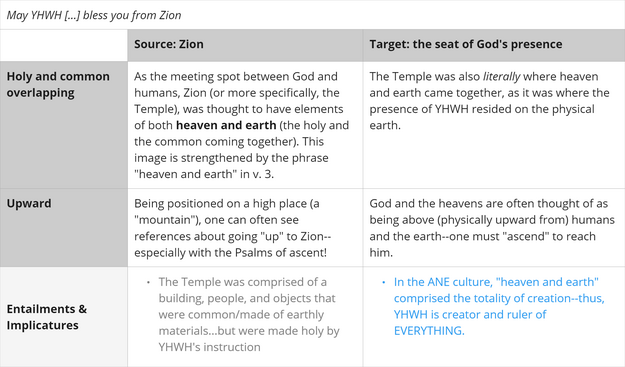Psalm 134 Verse-by-Verse
Welcome to the Verse-by-Verse Notes for Psalm 134!
The Verse-by-Verse Notes present scholarly, exegetical materials (from all layers of analysis) in a verse-by-verse format. They often present alternative interpretive options and justification for a preferred interpretation. The Verse-by-Verse Notes are aimed at consultant-level users.
The discussion of each verse of this psalm includes the following items.
- A link to the part of the overview video where the verse in question is discussed.
- The verse in Hebrew and English.[1]
- An expanded paraphrase of the verse.[2]
- A grammatical diagram of the verse, which includes glosses for each word and phrase.[3]
- A series of notes on the verse, which contain information pertaining to the interpretation of the psalm (e.g., meaning of words and phrases, poetic features, difficult grammatical constructions, etc.).
The People Bless YHWH (vv. 1-2)
- Participant analysis is especially important for understanding this psalm. There are two (groups of) speakers:
- (1) The people of Israel, the ones who have been journeying up to Jerusalem for a holy festival. They speak in vv. 1-2. Some scholars think this verbal exchange might have occurred just as the pilgrims arrived in Jerusalem, or just as they are leaving to go back home after the festival gathering.
- (2) The priests/Temple workers, who return the blessing to the people in v. 3. (There is some debate as to the identity of the "servants of YHWH" in v. 1: some believe it is the congregation of Israel, others believe it is the priesthood/Levites. For more details, as well as why we believe it is the priests, see our exegetical issue.) "The power of pronouncing blessings in Israel was especially vested in God’s appointed agents, namely, the priests".[4] The priests are the intermediaries of the exchange of blessing that takes place between YHWH and his covenant people. They themselves do not explicitly receive blessing in this psalm. And though YHWH's name appears in each verse, he does not speak or (explicitly) act.
- In terms of emotional content, it makes sense that this psalm, which immediately follows Psalm 133, would carry over some of those same joyful emotions associated with unity and blessing, as it celebrates the restored connection between YHWH and his people via rituals and prayer. Joy and camaraderie are felt throughout the psalm by both parties; and, the two appositive participial phrases referring to the addressees ("the ones who stand in the house of YHWH by night" in v. 1, and "the maker of heaven and earth" in v. 3) seem to convey the related emotions of respect (for the Temple workers) and awe/reverence (for YHWH).
- There are two important repeated roots, each occurring in all 3 verses of this psalm: bless (ברך) and YHWH (יהוה). These two words capture the main themes/thrusts of the psalm, which showcases an exchange of blessing between YHWH and his people, mediated by the priesthood.
- There are many features which indicate that this is a "twin psalm" with Psalm 133.
- Both psalms are very short (3 verses).
- Both psalms begin with the attention-getting particle הִנֵּה (cf. also the connection between 'dwelling' שבת and 'standing' עמד in the first verses).
- Both psalms mention the priests ('Aaron' in Ps 133, and the 'servants of YHWH' in Ps 134).
- Both psalms are about blessing.
- Both psalms mention Zion in verse 3.
v. 1
Watch the Overview video on v. 1.
| v. | Hebrew | Close-but-clear |
|---|---|---|
| ss | שִׁ֗יר הַֽמַּ֫עֲל֥וֹת | The song of the ascents. |
| 1a | הִנֵּ֤ה ׀ בָּרֲכ֣וּ אֶת־יְ֭הוָה כָּל־עַבְדֵ֣י יְהוָ֑ה | Come on! Bless YHWH, all servants of YHWH |
| 1b | הָעֹמְדִ֥ים בְּבֵית־יְ֝הוָ֗ה בַּלֵּילֽוֹת׃ | –the ones who stand in the house of YHWH by night! |
Expanded Paraphrase
The song of the ascents(, written for pilgrims coming to Zion for a holy festival). (The pilgrims, having just arrived at the Temple, say to the priests: ) Come on! Bless YHWH (because he is worthy of blessing) (and because blessing YHWH is part of serving him), all servants of YHWH(, you priests and Temple workers, whose job is to bless YHWH on behalf of all Israel)–the ones who stand (or serve) in the house of YHWH by night (especially when night vigils were held during holy festivals)! (In this way blessings will never cease, for somebody will always be blessing YHWH.)
Grammatical Diagram
Notes
- The section comprised of vv. 1-2 (minus the superscription) comprises the pilgrims' speech, and is set off by an inclusio, a Hebrew poetic feature where a word or phrase is repeated at the beginning and end of a piece of poetry. Here, the inclusio is bless YHWH.
- The superscription tells us that this is a (song) of ascents. For more information about this special group of psalms, see our page Psalms of Ascent.
- The verbs in this short psalm are interesting and unique: 3 imperatives (vv. 1b, 2ab), one jussive with imperative force (v. 3a), and two participles that serve as appositives for the participants (vv. 1c, 3b). This means that the commands given by the imperatives shape how we understand the psalm--in terms of an exchange of (commanded/requested) blessings. In verse 1, we have an imperative ("bless") followed by the participle functioning as an attributive ("[the ones who] stand").
- The particle glossed as Come on! (הִנֵּה) is a common attention-drawing device in biblical Hebrew. It is often translated "Look!" or "Here!" or something similar, but when it appears with an imperative (as is the case here with "bless") it has the sense of "Come" or "Come on".[5] For a more detailed look at the possible interpretations of this word, along with our reasoning for arriving at our interpretation, see our exegetical issue on this topic. It is also worth noting that Psalm 133, which has many parallels with this psalm, begins with the same word (after the superscription).
- What does it mean to bless YHWH? God blesses people by conferring good on them; we bless God by praising the good in him.[6]. See the Venn diagram below for a comparison and contrast of the ancient Hebrew and modern English understanding of the idea to bless.
- It is not clear who the servants of YHWH (עַבְדֵי יְהוָה) are. Some scholars think this refers to the whole congregation of Israel. For a full treatment of this issue, see our page Who are the "servants of YHWH" in Ps. 134:1? In short, the phrase probably refers to the priests/Temple and not the entire congregation of pilgrims. The "servants of YHWH" are referred to with an appositive in the following line (v. 1c): the ones who stand in the house of YHWH. Stand could refer to literal standing in the Temple (house of YHWH), or it could be a figurative way to say those who serve in the Temple[7]. See the Venn diagram below for a comparison and contrast between the ancient Hebrew and modern English understanding of this idea of servant.
- The noun "night" in the Hebrew phrase by night (בַּלֵּילוֹת) is plural, but English uses the singular in this case to indicate habitual or regular action. Night vigils were held in the temple in Jerusalem for the purpose of prolonged festive celebration (cf. Isa 30:29)[8], much like the festival gatherings that drew the people of Israel to the Temple. In general, night vigils were common in the Ancient Near East [9]. Some have speculated that this psalm displays a formulaic greeting or leave-taking, with the pilgrims either finally arriving at Jerusalem at night before the festival, or leaving before dawn after the festival is over.
- There's alliteration in 1b, with similar sounds repeated within and between בְּבֵית ('bebet') and בַּלֵּילוֹת ('balaylot') [10].
v. 2
Watch the Overview video on v. 2.
| v. | Hebrew | Close-but-clear |
|---|---|---|
| 2a | שְׂאֽוּ־יְדֵכֶ֥ם קֹ֑דֶשׁ | Lift up your hands toward the holy place, |
| 2b | וּ֝בָרֲכוּ אֶת־יְהוָֽה׃ | and bless YHWH! |
Expanded Paraphrase
Lift up your hands (as the gesture of prayer to YHWH which he decreed at the dedication of the Temple) toward the holy place (also known as the Temple)(, you who are in the courtyard, just outside the Temple), and bless YHWH (because he is our covenant God and worthy of blessing)!
Grammatical Diagram
Notes
- The command to lift up your hands is a parallel to the command to bless YHWH. Lifting of hands was a gesture associated with addressing Yahweh in prayer (Ps 28:2; cf. Ps 77:3) or, as here, in praise (Ps 63:5).[11].
- Holy place (קֹדֶשׁ) can signify the temple together with its precincts or the temple itself, or its nave/inner chamber.[12]. We have analyzed the adverbial accusative "holy place" as implying motion toward the holy place, which probably indicates that the priests, the congregation, or both, were standing in the courtyard and surroundings of the Temple, and that the priests were being instructed to lift their hands toward the Most Holy Place, inside the Temple where YHWH's presence resided. (For more details on our interpretation, see our exegetical issue on this Hebrew word.)
YHWH blesses the people (v. 3)
The second 'section' is just one verse, v. 3. This is the priests' return of blessing to the congregation. It is linked to the first section by the participle in apposition (the teal text in the below visual).

Watch the Overview video on v. 3.
| v. | Hebrew | Close-but-clear |
|---|---|---|
| 3a | יְבָרֶכְךָ֣ יְ֭הוָה מִצִּיּ֑וֹן | May YHWH bless you from Zion |
| 3b | עֹ֝שֵׂ֗ה שָׁמַ֥יִם וָאָֽרֶץ׃ | –the maker of heaven and earth! |
Expanded Paraphrase
(The covenant has obligations on both sides, which means blessing flows between them) (and the priests serve as intermediaries between the two) (so, in response to the blessing of the people to YHWH, the priests say to the pilgrims: ) May YHWH (,the one with authority to bless,) (reciprocally) bless you from Zion (where his presence is located)–the maker (and ruler) of heaven and earth(, that is, the one responsible for both heaven and earth and therefore responsible for blessing flowing back and forth)! (In this way we of Israel, on earth, worship our God in heaven whose presence still dwells on Zion.)
Grammatical Diagram
Notes
- The verb bless in this verse, though a repeated root, is unique in the psalm, because it is the only verb that is not an imperative or participle. It has jussive modality, meaning it expresses a third-person wish rather than a second- or first-person command. This makes sense given the shift of speaker and addressee that occurs in this verse: now the priests are speaking to the congregation, and they are invoking a blessing from YHWH onto the people.
- If the congregation of Israel is composed of many people, why is the second person masculine singular pronoun suffix -ךָ ("you") used in this address? The singular pronoun may be referring to the congregation as a whole, or perhaps directed at each individual in the congregation.[13] The pronoun could be considered a stereotyped element--a common device in the Hebrew Bible, which can be exemplified by the use of the singular "you" in the Aaronic blessing in Num 6:24-26.[14] The suffix is used generically and not intended to be directed at any one person.
- Zion was another name for Jerusalem and/or the Temple, where God's presence resided. See the table below for more details on the use of this imagery.
- Why would the psalmist choose to describe YHWH using the phrase the maker of heaven and earth? Many Ancient Near Eastern peoples understood the entire created universe to consist of two parts: heaven/the heavens (God's space), and earth (humans'/the natural world's space).[15] Thus, this phrase is an artful way to describe YHWH as the creator of the entire universe. What is more, this phrase could hint at the coming together of heaven and earth that happened at Zion (see imagery table).
- Maker (עֹשֵׂה) is functioning as an adjectival participle.
Legends
Grammatical diagram
| Visualization | Description |
|---|---|
| The clause is represented by a horizontal line with a vertical line crossing through it, separating the subject and the verb. | |
| The object is indicated by a vertical line that does not cross the horizontal line of the clause. Infinitives and participles may also have objects. If the direct object marker (d.o.m.) is present in the text, it appears in the diagram immediately before the object. If the grammar includes a secondary object, the secondary object will appear after the object, separated by another vertical line that does not cross the horizontal line of the clause. | |
| The subject complement follows the verb (often omitted in Hebrew) separated with a line leaning toward the right. It can be a noun, a whole prepositional phrase or an adjective. The later two appear modifying the complement slot. | |
| When a noun further describes or renames the object, it is an object complement. The object complement follows the object separated by a line leaning toward the right. | |
| In a construct chain, the noun in the absolute form modifies the noun in the construct form. | |
| Participles are indicated in whatever position in the clause they are in with a curved line before the participle. Participles can occur as nominal, where they take the place of a noun, predicate, where they take the place of a verb, or attributive, where they modify a noun or a verb similar to adjectives or adverbs. | |
| Infinitives are indicated by two parallel lines before the infinitive that cross the horizontal line. Infinitive constructs can appear as the verb in an embedded clause. Infinitive absolutes typically appear as an adverbial. | |
| The subject of the infinitive often appears in construct to it. In this situation, the infinitive and subject are diagrammed as a construct chain. | |
| The object of the infinitive is indicated by a vertical line that does not cross the horizontal line of the infinitival clause. | |
| Modifiers are represented by a solid diagonal line from the word they modify. They can attach to verbs, adjectives, or nouns. If modifying a verb or adjective, it is an adverb, but if modifying a noun, it is an adjective, a quantifier, or a definite article. If an adverb is modifying a modifier, it is connected to the modifier by a small dashed horizontal line. | |
| Adverbials are indicated by a dashed diagonal line extending to a horizontal line. These are nouns or infinitives that function adverbially (modifying either a verb or a participle), but are not connected by a preposition. | |
| Prepositional phrases are indicated by a solid diagonal line extending to a horizontal line. The preposition is to the left of the diagonal line and the dependent of the preposition is on the horizontal line. They can modify verbs (adverbial) or nouns (adjectival). | |
| Embedded clauses are indicated by a "stand" that looks like an upside-down Y. The stand rests in the grammatical position that the clause fulfills. Extending from the top of the stand is a horizontal line for the clause. If introduced by a complementizer, for example כִּי, the complementizer appears before the stand. Embedded clauses can stand in the place of any noun. | |
| When clauses are joined by a conjunction, they are compound clauses. These clauses are connected by a vertical dotted line. The conjunction is placed next to the dotted line. | |
| Within a clause, if two or more parts of speech are compound, these are represented by angled lines reaching to the two compound elements connected by a solid vertical line. If a conjunction is used, the conjunction appears to the left of the vertical line. Almost all parts of speech can be compound. | |
| Subordinate clauses are indicated by a dashed line coming from the line dividing the subject from the predicate in the independent clause and leading to the horizontal line of the subordinate clause. The subordinating conjunction appears next to the dashed line. | |
| Relative clauses also have a dashed line, but the line connects the antecedent to the horizontal line of the relative clause. The relative particle appears next to the dashed line. | |
| Sentence fragments are represented by a horizontal line with no vertical lines. They are most frequently used in superscriptions to psalms. They are visually similar to discourse particles and vocatives, but most often consist of a noun phrase (that does not refer to a person or people group) or a prepositional phrase. | |
| In the body of the psalm, a horizontal line by itself (with no modifiers or vertical lines) can indicate either a discourse particle or a vocative (if the word is a noun referring to a person or people group). A discourse particle is a conjunction or particle that functions at the discourse level, not at the grammatical level. Vocatives can appear either before or after the clause addressed to them, depending on the word order of the Hebrew. | |
| Apposition is indicated by an equal sign equating the two noun phrases. This can occur with a noun in any function in a sentence. |
| Hebrew text colors | |
|---|---|
| Default preferred text | The default preferred reading is represented by a black line. The text of the MT is represented in bold black text. |
| Dispreferred reading | The dispreferred reading is an alternative interpretation of the grammar, represented by a pink line. The text of the MT is represented in bold pink text, while emendations and revocalizations retain their corresponding colors (see below). |
| Emended text | Emended text, text in which the consonants differ from the consonants of the Masoretic text, is represented by bold blue text, whether that reading is preferred or dispreferred. |
| Revocalized text | Revocalized text, text in which only the vowels differ from the vowels of the Masoretic text, is represented by bold purple text, whether that reading is preferred or dispreferred. |
| (Supplied elided element) | Any element that is elided in the Hebrew text is represented by bold gray text in parentheses. |
| ( ) | The position of a non-supplied elided element is represented by empty black parentheses. For example, this would be used in the place of the noun when an adjective functions substantivally or in the place of the antecedent when a relative clause has an implied antecedent. |
| Gloss text colors | |
|---|---|
| Gloss used in the CBC | The gloss used in the Close-but-Clear translation is represented by bold blue text. |
| Literal gloss >> derived meaning | A gloss that shows the more literal meaning as well as the derived figurative meaning is represented in blue text with arrows pointing towards the more figurative meaning. The gloss used in the CBC will be bolded. |
| Supplied elided element | The gloss for a supplied elided element is represented in bold gray text. |
Shapes and colours on grammatical diagram
| Visualization | Description |
|---|---|
| The prepositional phrase is indicated by a solid green oval. | |
| The construct chain is indicated by a solid yellow oval. | |
| When the conjunction ו appears at the phrase-level (not clause-level), it is indicated by a solid light purple oval. | |
| The article is indicated by a solid blue oval. |
Expanded paraphrase
(For more information, click "Expanded Paraphrase Legend" below.)
| Expanded paraphrase legend | |
|---|---|
| Close but Clear (CBC) translation | The CBC, our close but clear translation of the Hebrew, is represented in bold text. |
| Assumptions | Assumptions which provide background information, presuppositions, entailments, and inferences are represented in italics. |
Bibliography
- Allen, Leslie C. 2002. Psalms 101–150 (Revised). Vol. 21. Word Biblical Commentary. Dallas: Word, Incorporated.
- DeClaisse-Walford, Nancy L., Rolf A. Jacobson, and Beth LaNeel Tanner. 2014. The Book of Psalms. New International Commentary on the Old Testament. Grand Rapids, MI: Eerdmans.
- Keel, Othmar. 1997. The Symbolism of the Biblical World: Ancient Near Eastern Iconography and the Book of Psalms. Winona Lake, Ind: Eisenbrauns.
- Kirkpatrick, Alexander Francis. 1897. The Book of Psalms. Cambridge: Cambridge University Press.
- Matthews, Victor Harold, Mark W. Chavalas, and John H. Walton. 2000. The IVP Bible Background Commentary: Old Testament. Electronic ed. Downers Grove, IL: InterVarsity Press.
- VanGemeren, Willem. 1997. New International Dictionary of Old Testament Theology & Exegesis. Grand Rapids, Mich.: Zondervan Pub. House.
Footnotes
134
- ↑ The Hebrew text comes from Open Scriptures Hebrew Bible, which presents the text of the Leningrad Codex (the Masoretic text). The English text is our own "Close-but-clear" translation (CBC). The CBC is a “wooden” translation that exists to provide a window into the Hebrew text. It is essentially an interlinear that has been put into English word-order. It is also similar to a “back-translation” (of the Hebrew) often used in Bible translation checking. It is important to remember that the CBC is not intended to be a stand-alone translation, but is rather a tool for using the Layer by Layer materials. The CBC is used as the primary display text (along with the Hebrew) for most analytical visualisations. It is also used as the display text for most videos.
- ↑ A legend for the expanded paraphrase is available near the bottom of this page, in the section titled "Legends."
- ↑ Legends for both the grammatical diagram and the shapes and colours on the grammatical diagram are available near the bottom of this page, in the section titled "Legends."
- ↑ NIDOTTE, 761.
- ↑ Allen 2002, 231.
- ↑ NIDOTTE, 764.
- ↑ NIDOTTE, 432; BDB, 764.
- ↑ De-Claisse Walford 2014, 940.
- ↑ Matthews and Walton 2000.
- ↑ Van der Lugt 2013, 417.
- ↑ Allen 2002, 238.
- ↑ Cf. BDB; Allen 2002, 238.
- ↑ Kirkpatrick 1906, 773.
- ↑ Allen 2002, 238.
- ↑ Keel 1997, 30.
